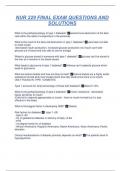NUR 229 FINAL EXAM QUESTIONS AND
SOLUTIONS
What is the pathophysiology of type 1 diabetes? ✅autoimmune destruction of the beta
cells within the islets of Langerhans in the pancreas
What is the result of the beta cell destruction in type 1 diabetes? ✅-pancreas not able
to make insulin
-decreased insulin production, increased glucose production (no insulin can't take
glucose out of blood and into cells to use for energy)
Where is glucose stored in someone with type 1 diabetes? ✅glucose can't be stored in
the liver so it remains in the blood stream
What leads to glycosuria in type 1 diabetes? ✅Kidneys can't reabsorb glucose which
leads to glycosuria
What are ketone bodies and how are they formed? ✅Ketone bodies are a highly acidic
substance formed when liver breaks down free fatty acids since there is no insulin
ONLY FOUND IN TYPE 1 DIABETES
Type 1 accounts for what percentage of those with diabetes? ✅About 5-10%
What is the pathophysiology of type 2 diabetes? ✅Insulin resistance - decreased
tissue sensitivity to insulin
(Cells fail to respond appropriately to insulin - there is insulin formed but it is less
effective in the body)
What is the biggest factor in developing DM2? ✅Obesity
Risk factors for diabetes ✅- type 1 <30
- type 2 >30
- Hx of gestational diabetes or delivery of baby >9 Ibs
- HTN
- 1st degree family Hx of diabetes
- African Americans, Hispanic Americans, Native Americans, Asian Americans, Pacific
Islanders
Clinical manifestations of diabetes primarily depends on what? ✅The patients level of
hyperglycemia
,What are the "three Ps" of clinical manifestations in diabetes? ✅Polyuria (excess
urine), polydipsia (excess thirst), polyphagia (excess eating)
Other clinical manifestations of diabetes? ✅Fatigue, weakness, vision changes,
tingling or numbness in hands or feet, dry skin, skin lesions or wounds that are slow to
heal, recurrent infections (vaginal in women), blurred vision (if blood sugar really high),
irritability
Sudden weight loss and dehydration may be a clinical manifestation of what? ✅Type 1
diabetes
Symptoms of type 1 diabetes are ________, while symptoms of type 2 diabetes usually
_______ ✅Acute (short/sudden); take longer
Effects of exercise with diabetes ✅- lowers blood sugar by decreasing insulin
resistance and need for insulin
- good even if no weight loss
- aids in weight loss, easing stress, and maintaining a feeling of well-being
- lowers cardiovascular risk
(Chart 46-4 p. 1497)
What patient education is needed for insulin self-management? ✅- use and action of
insulin
- symptoms of hypoglycemia and hyperglycemia
- blood glucose monitoring
- self-injection of insulin (have them demonstrate)
- insulin pump use
- safety!!!!! rotate injection sites, disposal of sharps, how to clean site before injection
- storage
Strategies for safe storage of insulin ✅-avoid extreme temps
-vials not in use should be refrigerated
-vials in use can be kept at room temp if used within 30 days
Manifestations of hypoglycemia ✅Adrenergic symptoms- sweating, tremors,
tachycardia, palpitations, nervousness, hunger
CNS symptoms- dizziness/lightheadness, inability to concentrate, headache, confusion,
memory lapses, slurred speech, drowsiness
Severe hypoglycemia- disorientation l, seizures, loss of consciousness, death
What is the first thing you would do if you walk into a room of a diabetic and found the
patient sweating, confused? ✅Check their blood sugar
What causes hypoglycemia? ✅too much insulin or oral hypoglycemic agents; too little
food; excessive physical activity
, Initial treatment for hypoglycemia? ✅Give 15g of fast-acting, concentrated
carbohydrate
Can also give 3-4 glucose tablets or 4-6 oz of juice or regular soda
Patients that have diabetes should be instructed to carry what with them? ✅A form of
fast-acting sugar like glucose tablets
Management after a hypoglycemic incident ✅-Retest blood glucose in 15 minutes;
retreat if <70 or if symptoms persist more than 10-15 minutes and testing is not possible
-Provide a snack with protein and carbohydrate unless the patient plans to eat a meal
within 30-60 minutes
Treatment of hypoglycemia if patient cannot swallow or is unconscious ✅-
Subcutaneous or intramuscular glucagon (1 mg)
-25 to 50 mL of 50% dextrose solution IV
Long-term vascular complications of diabetes ✅-vessels get damaged (especially
small ones)
-accelerated atherosclerotic changes, coronary artery disease, cerebrovascular
disease, and peripheral vascular disease
-diabetic retinopathy and nephropathy
Long-term neuropathic complications of diabetes ✅-peripheral neuropathy (tingling,
prickling, burning leading to eventual numbness causes by demyelination of the nerves)
-autonomic neuropathies (CV, GI, urinary)
-hypoglycemia unawareness
-sexual dysfunction
Long-term nephropathy (kidney damage) complications of diabetes ✅When blood
sugar is elevated for an extended amount of time, the kidneys filtration mechanisms are
stressed allowing blood proteins to leak into the urine > pressure in blood vessels of
kidneys increase > stimulus for kidney dysfunction/disease
If your patient were to ask you "how could retinopathy occur with my diabetes?", how
would you respond? ✅It is caused by changes in small blood vessel in retina, which
then leak fluid, causing swelling & forming exudates
What are complications caused by neuropathy in feet? ✅-Patients are less likely to feel
their feet and they are unlikely to know if they are injured (even a small cut can
eventually lead to ulcers)
-Injuries take a while to heal because of increased blood sugars




